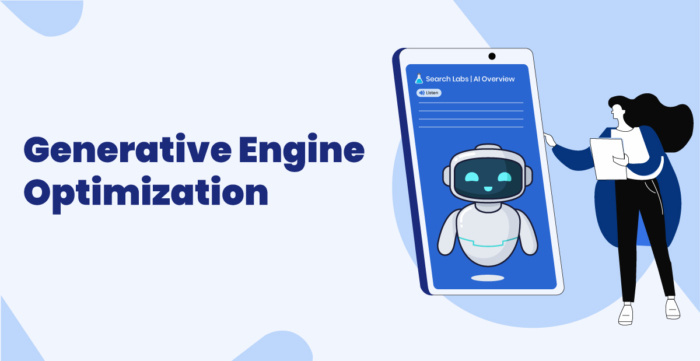Generative Engine Optimization (GEO): The Next Content Frontier
- August 8, 2025

Generative Engine Optimization (GEO) is the strategic practice of optimizing content to be discovered, cited, and referenced by AI-powered systems like ChatGPT, Perplexity, and Google’s AI Overviews. While traditional SEO focuses on ranking web pages, however, GEO’s goal is to position your content as a definitive, trustworthy source that AI can directly pull from when generating a response.
Why Mastering GEO is Non-Negotiable in 2025 and Beyond
The way we search for information is undergoing a seismic shift. As a result, by 2026, a significant portion of all search queries will move from traditional search engines to conversational, AI-driven interfaces. Platforms like ChatGPT are already being used by hundreds of millions of people weekly, which is why this is a profound and rapid change in user behavior.
This shift isn’t just about a new type of technology; rather, it’s about a new way of consuming information. Consequently, content that is optimized for GEO has been shown to increase its citation rate in AI responses by over 300% compared to traditional SEO content. This creates a powerful new channel for brand visibility and audience engagement.
GEO vs. SEO: A Fundamental Shift in Strategy
| Traditional SEO | Generative Engine Optimization (GEO) |
| Goal: Drive traffic to a website | Goal: Get content cited directly in AI responses |
| Focus: Keyword density, backlinks | Focus: Natural language, conversational context |
| Success Metric: Page rankings, organic traffic | Success Metric: AI citation volume, answer prominence |
| Approach: Optimizing for a page | Approach: Optimizing for a definitive answer |
| End Result: Users click a link to your site | End Result: AI provides your information directly to users |
The 5 Core Pillars of an Unbeatable GEO Strategy
To succeed with GEO, your content must be structured to be both helpful to humans and easily digestible for AI systems.
1. Lead with the Definitive Answer. AI systems are built to provide immediate, concise answers. Therefore, you should start your content with a direct response to the core query before expanding with supporting details.
- Question: “What is blockchain?”
- GEO-Optimized Answer: “Blockchain is a decentralized digital ledger that records transactions across many computers. Ultimately, its design makes it nearly impossible to alter or hack, ensuring a secure and transparent record.”
2. Align with Conversational Queries. People interact with AI assistants differently than they type into a search bar. Thus, your content should anticipate these conversational, question-based keywords.
- Instead of: “blockchain definition”
- Optimize for: “What is blockchain and how does it work?” or, “Explain the benefits of blockchain technology.”
3. Implement Scannable, Modular Content. AI models excel at extracting specific pieces of information. For this reason, you should organize your content into logical, self-contained units that AI can easily pull and cite.
- Use bold, clear subheadings (H2, H3) to segment topics.
- Structure information using bullet points and numbered lists.
- Present data points, definitions, and statistics in standalone, extractable formats.
4. Build Unquestionable Authority (E-E-A-T). AI systems are trained to prioritize content from credible and authoritative sources. As a result, you must establish your expertise to earn the AI’s trust.
- Provide clear author bylines with credentials.
- Include publication dates and regular update timestamps.
- Ground your claims in verifiable facts and widely accepted knowledge.
5. Design for Easy Citation. Craft your content so that it’s inherently quotable. In other words, think of each key piece of information as a potential citation.
- Formulate core claims as standalone, factual statements.
- Frame key statistics and data points as distinct facts.
- Utilize structured data (schema markup) to explicitly label your content’s key elements, for example, by making them even more discoverable.
A Real-World Example of GEO in Action
A B2B SaaS company applied GEO principles to their article, “What is Customer Churn?” The results were transformative.
- Before GEO: The article received a high volume of organic search traffic but zero AI citations.
- After GEO: While organic traffic remained strong, meanwhile, the article began to be cited by AI assistants dozens of times per month. Ultimately, this new visibility led to a significant increase in high-quality inbound leads, which in turn drove a 23% higher conversion rate.
The company’s strategy involved moving the core definition to the very first sentence, structuring the content with conversational subheadings like “Why Does Customer Churn Matter?”, and presenting key industry benchmarks in bullet points.
Avoid These Common GEO Pitfalls
- Keyword Stuffing: AI prioritizes natural language and context. Therefore, overloading your content with keywords will make it sound unnatural and is unlikely to improve your standing.
- Burying the Lede: Don’t hide your most important information. Instead, the key answer or definition should be the very first thing the reader (and the AI) encounters in a section.
- Ignoring Credibility: The foundation of GEO is authority. Consequently, content that lacks a credible author, clear dates, or factual backing will be consistently overlooked by AI systems.
The Future is AI-Discoverable
Generative Engine Optimization is not a fleeting trend; on the contrary, it is the evolution of content strategy. The brands and creators who proactively embrace GEO are positioning themselves for unparalleled visibility in the future of information retrieval. The shift from traditional SEO to GEO is about creating exceptional, authoritative content that can serve users regardless of how they discover it.
Begin your GEO journey today by auditing your content for an answer-first structure, creating conversational FAQ sections, and ensuring your expertise is clearly communicated. In conclusion, the competitive advantage belongs to those who start now.
FAQs
GEO is the practice of optimizing content to be cited and referenced by AI-powered systems like ChatGPT and Google’s AI Overviews. Its goal is to get your information directly into AI-generated responses, rather than just ranking a webpage.
While SEO focuses on ranking web pages to drive traffic, GEO’s primary goal is to establish content as an authoritative source for AI. It prioritizes a conversational, answer-first structure and source credibility over keyword density.
As a significant percentage of search queries move to conversational AI interfaces, GEO ensures your content remains discoverable. It allows you to gain brand visibility and authority by being the source that AI systems cite for user questions.
Your content should be structured with an answer-first approach, leading with a direct and concise response. Use clear headings, bullet points, and numbered lists to create modular, scannable sections that are easy for AI to extract.
The most important factor is creating content that demonstrates expertise, authoritativeness, and trustworthiness (E-E-A-T). AI models prioritize sources from reputable, credible authors who provide accurate, factual, and well-supported information.









